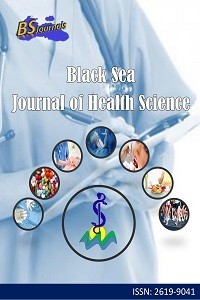Stereolojik Bir Araştırma: Akciğer Hacmi ve İzdüşüm Yüzey Alanı Arasındaki İlişki
Akciğer, Radyografi, Toraks, Tomografi tarayıcılar
A Stereological Research: The Relationship between Lung Volume and Projected Surface Area
Lung, Radiography, Thorax, Computed tomography,
___
- Akbaş H, Şahin B, Eroğlu L, Odacı E, Bilgiç S, Kaplan S. 2004. Estimation of the breast prosthesis volume by the Cavalieri Principle using magnetic resonance images. Aesthetic Plast Surg, 28(5): 275-280.
- Bilgic S, Sahin B, Sönmez OF, Odacı E, Colakoglu S, Kaplan S. 2005. A new approach for the estimation of intervertebral disc volume using the Cavalieri principle and computed tomography images. Clin Neurol Neurosurg, 107(4): 282-288.
- Black KJ. 1999. On the efficiency of stereologic volumetry as commonly implemented for three-dimensional digital impages. Psychiatry Res, 90(1): 55-64.
- Canan S, Şahin B, Odacı E, Unal B, Aslan H, Bilgic S. 2002. Stereolojik uygulamalarda kullanılan pratik gereçler ve bilgisayar destekli stereolojik analiz cihazları. Turkiye Klinikleri J Med Sci, 22(Suppl 1): 7-14.
- Delgado BJ, Bajaj T. 2021. Physiology, lung capacity. URL: https://www.ncbi.nlm.nih.gov/books/NBK541029/ (erişim tarihi: 11.08.2020).
- Demirbaş N, Kutlu R. 2018. Sigaranın akciğer yaşı ve solunum fonksiyon testleri üzerine olan etkisi. Cukurova Medical J, 43(1): 155-163.
- Gundersen HJ, Jensen EB. 1987. The efficiency of systematic sampling in stereology and its prediction. J Microsc, 147(3): 229-263.
- Hsia CC, Hyde DM, Ochs M, Weibel ER. 2010. An official research policy statement of the American Thoracic Society/European Respiratory Society: standards for quantitative assessment of lung structure. Am J Respir Crit Care Med, 181(4): 394-418.
- Jelsing J, Rostrup E, Markenroth K, Paulson OB, Gundersen HJG, Hemmingsen R. 2005. Assessment of in vivo MR imaging compared to physical sections in vitro: A quantitive study of brain volumes using stereology. Neuroimage, 26(1): 57-65.
- Kim YY, Shin HJ, Kim MJ, Lee MJ. 2016. Comparison of effective radiation doses from X-ray, CT, and PET/CT in pediatric patients with neuroblastoma using a dose monitoring program. Diagn Interv Radiol, 22(4): 390-394.
- Knudsen L, Brandenberger C, Ochs M. 2020. Stereology as the 3D tool to quantitate lung architecture. Histochem Cell Biol, 155(2): 163-181.
- Konheim JA, Kon ZN, Pasrija C, Luo Q, Sanchez PG, Garcia JP. 2016. Predictive equations for lung volumes from computed tomography for size matching in pulmonary transplantation. J Thorac Cardiovasc Surg, 151(4): 1163-1169.
- Marcos R, Monteiro RA, Rocha E. 2012. The use of design-based stereology to evaluate volumes and numbers in the liver: a review with practical guidelines. J Anat, 220(4): 303–317. DOI: 10.1111/j.1469-7580.2012.01475.x.
- Mazonakis M, Damilakis J, Maris T, Prassopoulos P, Gourtsoyiannis N. 2002. Comparison of two volumetric techniques for estimating liver volume using magnetic resonance imaging. J Magn Reson Imaging, 15(5): 557-63.
- Mühlfeld C, Knudsen L, Ochs M. 2012. Stereology and morphometry of lung tissue. Cell ımaging techniques. methods in molecular biology (methods and protocols) In: Taatjes D, Roth J editors. Humana Press, Totowa, 931: 55-68.
- Ödev K. 2010. Toraks Radyolojisi, İstanbul, Nobel Tıp Kitapevleri, 2.baskı. İstanbul, Turkey.
- Özlü T, Metintaş M, Karadağ M, Kaya A. 2010. Solunum sistemi hastalıkları. 1.baskı, İstanbul, İstanbul Tıp Kitapevi, 650-653, İstanbul, Turkey.
- Pellegrino R, Viegi G, Brusasco V, Crapo RO, Burgos F, Casaburi REA. 2005. Interpretative strategies for lung function tests. Eur Respir J, 26(5): 948-968.
- Quekel LG, Goei R, Kessels AG. 2003. The limited detection of lung cancer on chest X-rays. NTvG, 147(22): 1048-1056.
- Sahin B, Acer N, Sonmez OF, Emirzeoğlu M, Basaloğlu H, Uzun A. 2007. Comparison of four methods for the estimation of intracranial volume: a gold standard study. Clin Anat, 20(7): 766–773.
- Sahin B, Emirzeoğlu M, Uzun A, İncisu L, Bek Y, Bilgic S. 2003. Unbiased estimation of the liver volume by the Cavalieri principle using magnetic resonance images. Eur J Radiol, 47(2): 164-170.
- Sahin, B, Celenk C, Basoglu A, Sengul B, Sengul A. 2013. The effect of minimally ınvasive surgical repair on the lung volumes of patients with pectus excavatum. Thorac cardiov Surg, 62(03): 226–230.
- Schneider JP, Ochs M. 2013. Chapter 12- Stereology of the Lung. Methods in Cell Biology. In:Conn PM editors. Academic Press, pp.257-294. NewYork, USA.
- Skinner S. 2013. Radiation safety. Australian Family Physician, 42(6): 387-389.
- Şahin B, Elfaki A. 2012. Estimation of the volume and volume fraction of brain and brain structures on radiological images. Neuroquantology, 10(1): 87-97.
- Vasilescu DM, Phillion AB, Kinose D, Verleden SE, Vanaudenaerde BM, Verleden GM. 2020. Comprehensive stereological assessment of the human lung using multiresolution computed tomography. J Appl Physiol, 128(6): 1604-1616.
- Weibel ER, Hsia CC, Ochs M. 2007. How much is there really? Why stereology is essential in lung morphometry. J Appl Physiol, 102(1): 459-467.
- Wiebe BM, Laursen H. 1995. Human lung volume, alveolar surface area, and capillary length. Microsc Res Tech, 32(3): 255–262.
- World Health Organization Department of Public Health, Environmental and Social Determinants of Health. 2016. Chapter 1: Scientific background. In: WHO, eds. Communicating radiation risks in paediatric imaging. Genova, p.12-27.
- Yayın Aralığı: Yılda 4 Sayı
- Başlangıç: 2018
- Yayıncı: Cem TIRINK
Molar Incisor Malformation in Three Cases
Bariyatrik Cerrahide Postoperatif Komplikasyonların Önlenmesinde Sağlık Okur Yazarlığının Önemi
Cemalettin DURGUN, Emine Kübra DİNDAR DEMİRAY, Sevil ALKAN, Mehmet DURGUN
Internet Addiction among Secondary School Students Conditioned By Gender and Age
Igor LUKİĆ, Nikola SAVİĆ, Ivana VUKOSAVLJEVİĆ, Nevena RANKOVİĆ, Dragica RANKOVİĆ
Disabled Children and Communication
Nazlı Melis MİSYAĞCI, Çiğdem Müge HAYLI
Evaluation of the Applications to the Patient Rights Unit
Bahadır YAZICIOĞLU, Elif DİKMETAŞ YARDAN
Comparison of Refractive Changes Following Pseudophakic Vitrectomy with or without Gas Tamponade
Sami YILMAZ, Ayşegül MAVİ YILDIZ, Mehmet Emin ASLANCI, Remzi AVCI
Safa KURNAZ, Gülsen KİRAZ, Burçak EMEK
COVID-19 Pnömonisi - Brusella spp. Koenfeksiyonu : Olgu Sunumu
Emine Kübra DİNDAR DEMİRAY, Hanife Nur KARAKOÇ, Hacer AKŞİT, Erdinç EREN, Özgür PAŞA, Gökhan ŞAHİN, Ömer DURAN, Fadime GÜLPINAR, Saadet YILDIRIM, Edip YILDIZ, Eren BEKTAŞ
